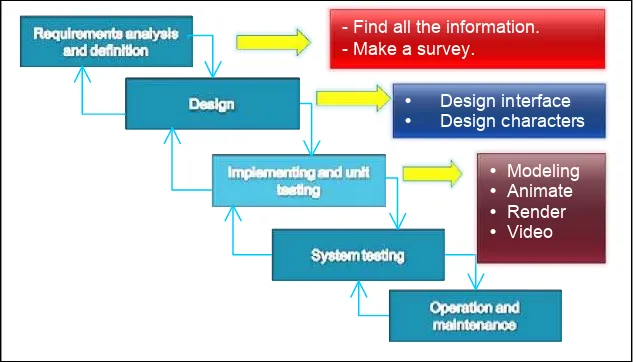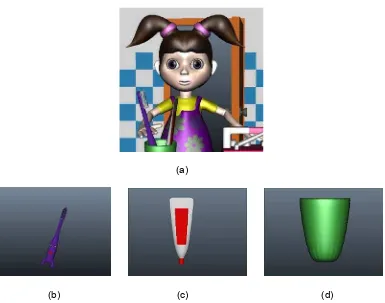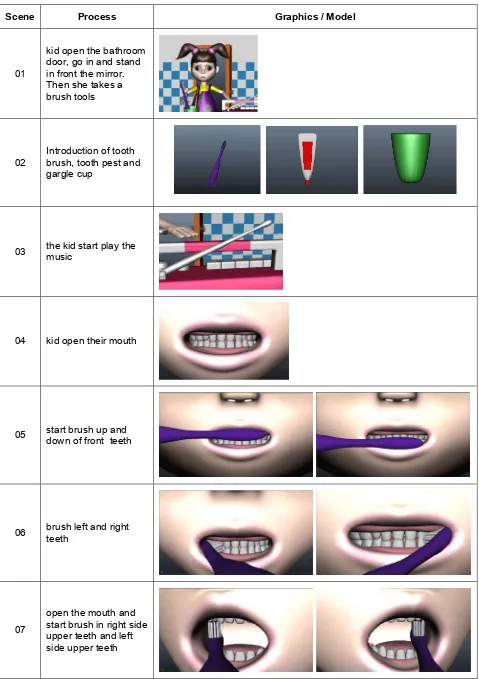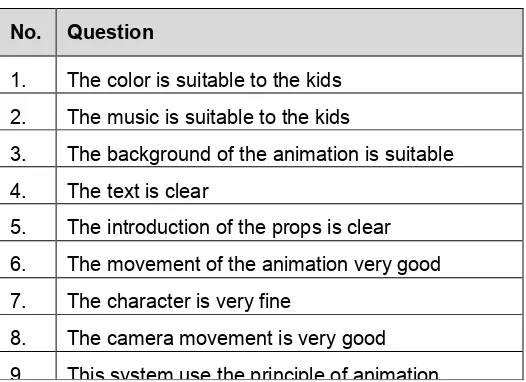DISABILITY LEARNING TOOL:
This research is an attempt of combining music with the 3D animation technique in order to develop a disability-learning tool which can be used as one of occupational therapy for autism children. Autism is a developmental disability of the brain, much like dyslexia, mental retardation, or attention deficit disorder that often makes it hard to communicate with and relate to others. The treatment that we are going to apply in our research is related to the occupational therapies which involved music, multisensory stimulant and computer usage. Occupational therapy assists autistic people in developing the skills for daily job such as brushing teeth. Music can stimulate brain and help individuals with a wide range of cognitive and emotional challenges to improve their ability to function. Music primarily can help autism children improve their observable level of functioning and self-reported quality of life in various domains such as cognitive functioning, motor skills, emotional and effective development, behavior and social skills. The problem that we are trying to overcome by doing this project is the independence among autism children. At the autism centre where we did our research, they are manually taught by parent or teachers and they have to teach the same thing every day. For example, the teachers have to show them every day on how to brush teeth using the teeth set and the big tooth brush. They seem cannot remember all the steps. In this research, by collaborating these elements, we try to develop a 3D animation disability-learning tool to help in stimulating independence in autism children. Music is included in the animation as part of the treatment. The objectives of this projects are first to investigate and analyze the acceptance of different types of music among autism children. Our second objective is to develop a 3D animation that show steps in brushing teeth according to the beat of the selected music. The third objective is to analyze the effectiveness of the application in stimulating remembrance brushing technique skills. 3D animation is a technique that can visualize characters or movement as same as in the real life. The current technology of 3D animation exist today is amazing. This application which is called Disability Learning Tool: Brushing-Teeth Using Music for Autism has been tested to a group of autism children with mild cases and has shown positive result. It can be seen that the independence in the autism children gradually increased. However, there’s a lot more to do for further improvement and we are going to look into each of these weaknesses in detail.
Keywords: Disability Learning, music therapy, 3D animation.
1
INTRODUCTION
Autism is a developmental disability of the brain that begins at birth or within the first two-and-a-half years of life. Most autistic children are perfectly normal in appearance, but spend their time engaged in qaapuzzling and disturbing behaviors which are markedly different from those of typical children. Autism is not a form of mental retardation. Though many autistic people appear to function as retarded, they are frequently quite intelligent. Autism people can hardly speak, thinking and hard to communicate with others, like the normal people do. In other meaning they have their own world. Autism patient ranges in severity from mild cases to severe forms require social support and medical supervision throughout his or her life. According to the Autism Society of America, "autism...occur[s] in approximately 15 of every 10,000 individuals...[and]...nearly 400,000 people in the U.S. today have some form of autism." The number of people diagnosed with autism has increased dramatically since the 1980s, partly due to changes in diagnostic practice; the question of whether actual prevalence has increased is unresolved [8]. In [3], Doja A and Roberts SW state that the prevalence of autism is about 1-2 per 1,000 people; the prevalence of ASD is about 6 per 1,000 with about four times as many males as females.
contact with others, an intense wish for sameness in routines, muteness or abnormality of speech, high levels of Visio-spatial skills, but major learning difficulties in other areas. Second is Aspergers Syndrome Disorder (ASD). A Person with ASD can exhibit a variety of characteristics and the disorder can range from mild to severe. They deficiencies in social skill and have difficulties with transitions or change, also have a great difficulty reading body language and determining proper body space. Some of them have reduced sensitivity to pain and an increased sensitivity to bright lights and loud noises. They also have average or above-average intelligence. Third is Childhood Disintegrative Disorder which includes severe regression in communication skills, social behavior, and all developmental motor skills. Fourth is Rett Syndrome, a neurological and developmental disorder that mostly occurs in females and is marked by poor head growth. Loss of muscle tone is usually the first symptom. Other early symptoms may include problems crawling or walking and diminished eye contact. They stop using their hands to do things and often develop stereotyped hand movements, such as wringing, clapping, or patting their hands. The inability to perform motor functions is perhaps the most severely disabling feature of Rett syndrome. The last is Pervasive Developmental Disorder-Not Otherwise Specified (PDDNOS). Children with PDDNOS either do not fully meet the criteria of symptoms used to diagnose any of the four specific types above, and/or do not have the degree of impairment described in any of the above four specific types.
There are a lot of studies that suggest different treatments for autistic children. The treatments that will be discussed next in this paper are those related on achieving the research objectives. One of the treatments is Applied Behavioural Analysis (ABA) [2].In this treatment, the autistic child is paired with a therapist and follows some procedures. The procedures are the therapist requests or direct the autistic child for an action.If the child complies, he is given a reward in the form of a tiny food treat, a high five, or any other reward that means something to the child. If the child does not comply, he does not receive the reward, and the trial is repeated. On the other hand, occupational and auditory therapies are treatments which involve trying to filter out the hearing sensory stimuli experienced by an autistic child in order for him or her to perform daily life activities. Music therapy primarily help autism children improve their observable level of functioning and self-reported quality of life in various domains such as cognitive functioning, motor skills, emotional and effective development, behavior and social skills. By using music experiences for instance singing, and listening, the measurable goals and objectives of the treatment could be achieved. Another treatment is the use of computers which also has actually been found to be more than beneficial. Since the beginning of 1980, Computer Assisted Instruction (CAI) has been used systematically in special education [5]. It relates perception, motivation, communication and behaviour characteristics of autistic children to features of computer-assisted learning. Video-taped evaluations showed higher enthusiasm ratings in computer-sessions than personal instruction sessions. Two recommendations that offered to enable computers to be maximally beneficial in assessing the learning process and remediating learning problems are selecting appropriate software and integrating computer instruction within the classroom environment.
2
BACKGROUND
In learning and teaching, teachers that teach the autism children have a syllabus or book to teach these autism children. One of the parts in the syllabus is hygiene and health. The objective of this syllabus is to enable student to name and label personal care tool and functionality of personal care. For example learning the name of the tooth brush and tooth pest. First the teacher explains to student the importance of rental hygiene. Then the teacher will demo how to use and brush the teeth. At the Autism School where this data research has been gathered, the autism children are manually taught by parent or teachers. The teacher uses a teeth set and a big tooth brush. Every day the teacher must show them how to brush their teeth because they just cannot remember the steps. This is where our motivation on this project began. We make an effort to use the computer technology as one approach in teaching and learning of autism children. In this research, we try to develop a 3D animation disability-learning tool to help in simulating independence in autism children. Music is included in the animation as part of the treatment. The objectives of this projects are first to investigate and analyze the acceptance of different types of music among autism children. Our second objective is to develop a 3D animation that show steps in brushing teeth according to the beat of the selected music. The third objective is to analyze the effectiveness of the application in simulating remembrance brushing technique skills. This application which is called Disability Learning Tool: Brushing-Teeth Using Music for Autism will be tested to a group of autism children. The 3D animation tool could help the autism children on their remembrance of steps in brushing teeth, when played over and over again.
3
METHODOLOGY
During the requirement analysis, data for the research were gathered from two methods. First is through the documentations, journal and proceeding. Second, surveys that have been done at two Autism Centres to collect useful information related with autism characteristic that can be apply when developing the disability learning and teaching tool of 3D animation. Fig. 1 below illustrates the whole combination process of research and system methodologies.
Outline: This learning tool is demonstrating the technique of brushing teeth. The music is used to help the kids remember the step of brushing the teeth. The movie starts with the environment in the bathroom. Suddenly the door is opened. A kid around 6 years old comes in and wants to brush her teeth. Her face is so tired so she washes her face. After that she takes a brush. Then she takes the tooth pest and squeezes a portion onto the brush. Then she switches on the radio to play the music. When the music starts playing, she also starts brushing her teeth following the tone of the music. After
finish, she gargles, cleans up her mouth and smile. The whole duration on this project is not less than 5 minute. It is a short interval because autism children won’t be able to listen or focus on certain task more than 5 minute. The frame rate is following the scene. In this project the frame rate is 25 frames per second.
3.2 Media Creation
This section will explain the production of texts, graphics, audio and animation for the prototype .
3.2.1 Production of Texts
Text is important for given description and detail. The production of text for the prototype must be easily readable and simple in order to fulfill the learner’s needs. The texts that will introduce the props should be big enough for display on the scene. The lettering color of the text should be contrast with the background. This contrasting technique makes the words easy to see and read. The type font used for this prototpye is Comic Sans MS.This type of fonts are because it is simple, easy to understand, and read by the autism learner.
3.2.2 Production of Graphics
Production of graphic is the finishing graphics prepared for the design interface, characters and the environment. The images are scanned from the sketches on drawing paper. The image for the main character is scanned from the magazine. The side and front face of the character must be sketched. The bitmap images were converted to vector images to reduce the file size and saved as .jpeg images. The images were then imported into Autodesk Maya 2009 software as a guide for modeling the character in 3D.
3.2.3 Production of Audio
The audio is very important in this project. It is because the music is absolutely applied to help the autism children to remember the steps. The 3D animation should be fully supported by an audio. It gives an interesting effects for 3D animation and moreover it makes the learning process is easy to understand. It encourages student especially student with autism to follow the step to brush the teeth. Some of the autism children can listen to the music as long as the music not too loud or too shrill. After various of experiments, based on the authors heuristic evaluation, the best kid song that can enlighten most of the autism children at selected autism school, is Do Re Me song. All the steps of brushing teeth in the 3D animation movie follow Do Re Mi song
3.2.4 Production of Animation
The animation is done using Autodesk Maya 2009 software.The animation used are using key frame. The blame shape is use to develop the animation on the face part of the main character. After creating the face, it is necessary to duplicate it. Then design the face into more faces and shape. These are done by highlighting all the duplicated faces and also highlighting the original face and from the menu, choose animation and blend shape to create blend shape for the faces.
3.2.5 Production of Video
This is the important part of the tools. The Adobe Premiere Pro CS3 is used to combine all the animation files that have been done using Autodesk Maya . All the rendered scenes will be imported into Adobe Premiere. All the scenes are combined to obtain the complete movie. Music is inserted and aligned with the movie.
4
SYSTEM DESCRIPTION AND IMPLEMENTATION
Implementation phase for the project begins after all the data, information or material needed are gathered and compiled. This section will explain the production and implementation process which encompasses the text, graphic, audio and animation production, as well as the integration of all the above mentioned productions into a prototype. Media integration is the process of integrating the created multimedia elements.
4.1 Media Integration
4.2 3D Models
Several models that have been created in this tool are as shown in Fig. 2(a) to (d) below. Fig. 2(a) is the main character of the scene. Fig 2(b) – (d) are the props used for brushing teeth. They are tooth brush, tooth pest and gargle cup.
(a)
(b) (c) (d)
Fig 2 : 3D Model. (a) Character, (b) tooth brush, (c) tooth pest, (d) gargle cup
4.3 Animation
Animation is a process of giving motion to the still images. All the 3D models that have been created will be animated and rendered separately according to the scene. Then these entire separate file will be combined in sequence to produce a complete learning tool. There are a number of scenes starting from the introduction of the props or objects, follow by the steps for brushing teeth. These scenes are go along with by the Do Re Mi song. Each step in brushing teeth follows the tune of the song.
Table 1 : The sequent of the scene and process
Scene Process Graphics / Model
01
kid open the bathroom door, go in and stand in front the mirror. Then she takes a brush tools
02
Introduction of tooth brush, tooth pest and gargle cup
03 the kid start play the music
04 kid open their mouth
05 start brush up and down of front teeth
06 brush left and right teeth
07
09
open the mouth and start brush in right side lower teeth and left side lower teeth
11 Gargle, blink eye, smile
5
TESTING AND RESULTS & ANALYSIS
5.1 Testing
Two different target groups were involved in 2 cycles of testing. The first group was the autism students with ranging ages from 5 to 12 years old. There were 8 students altogether. For these group, the experiments were conducted for them by using a personal laptop with high performance to support multimedia which connected to a big LCD Panel. On the other hand, the other group was the teachers who work at the autism centre/school. For this testing, we managed to get three teachers. These kind of experiments were prepared to verify the content whether it is appropriate with the target user’s level of understanding. In addition, they were asked upon the usability of the application in term of learning and teaching tool as well as the functionality of the tool’s design technically. The teachers have given some opinion and comment about the system.
In general, both of the target groups were tested mostly on their understanding and the acceptance of the system. On top of that, during the testing, some observations and interviews have been made towards the autism students’ attitude. Some simple questions have been asked. For example “what it this? ”, “where is the tooth brush? ” and so on. The purpose of carrying out those questions during the experiment is to test their understanding and learning.
5.2 Test Strategy
The heuristic usability testing was done through a set of questionnaires which consists 15 questions and the functionality test has 9 questions as shown partly in Table 3 and 4. Each question has 5 level of answer. The person who done the tests need to mark the suitable scale for each question. The scales are from 1 to 5 which indicate the level of Strong Disagree, Disagree, OK, Agree, Strong Agree respectively.
5.3 Results and Analysis
Table 3 : Usability Questionnaires
Table 4 : Functionality Questionnaires
6
CONCLUSION
The system shows a positive result in increasing the independence among autism children. The collaboration of 3D animation and music therapy gives quite a significance of contributions in helping the autism children to remember the steps of brushing teeth. Not also that, this tool can be one of the learning and teaching tool for the teacher and the parents to teach autism children. We make an effort to use the 3D animation as one approach in teaching and learning of autism children. Furthermore, they should be given opportunity and chances to be in IT environment. All of the autism children are very happy and enjoy using the tools. The tool has its own strength. However, there are some weaknesses of the tool and they will be enhanced for improvement.
No. Question
1 Overall, I am satisfied with how easy it is to use this system
2. It was simple to use this system
3. This system help me in doing the task
4. The kids feel comfortable using this system
5. It was easy to learn on this system
6. I believe kids independence level can be increased
7. The message that this system show is clear
8. It is easy to use anywhere
9. The introduction of the props is clear
No. Question
1. The color is suitable to the kids
2. The music is suitable to the kids
3. The background of the animation is suitable
4. The text is clear
5. The introduction of the props is clear
6. The movement of the animation very good
7. The character is very fine
8. The camera movement is very good
6.1 Strengths
• The character is suitable
The character is suitable and realistic for the kids from age 3 to 18 years old.
• The text is clear
The text is big and the color of the text is suitable.
• The intro of the tools are clear
The modeling of the brush teeth, tooth paste and glass are very clear.
• The animation is suitable for the kids
6.2 Weeknesses
• Too much things display on the animation.
The autism children easily confused seeing too much things at one time.
• The background of the color must be plain.
Some of the autism children got confused to see things more than two colors.
• The duration of music need to be slow and short
Some of autism children cannot focus on the animation when they hear music too long.
For further improvement, the movement of brushing the teeth should be counted. Counting help autism children to focus on how many time to do the steps. Another improvement that can be done is to increase the photorealism of the 3D models as well as to vary the views in the 3D animation. Texture can also be applied in order to get a model with their own depth.
ACKNOWLEDGEMENT
The authors would like to thank Universiti Teknikal Malaysia Melaka for the research grant awarded to the first author to carry out the research study. Special thanks also to The National Autism Society of Malaysia (NASOM) for their cooperation all the way the research was carried out.
REFERENCES
[1] American Psychiatric Association. Diagnostic and Statistical Manual of Mental Disorders. 4th, text revision (DSM-IV-TR) ed. 2000. ISBN 0890420254. Diagnostic criteria for 299.00 Autistic
Disorder.
[2] Lovaas, O. I., Behavioral treatment and normal educational and intellectual functioning in young autistic children. (1987).Journal of Consulting and Clinical Psychology,55, 3-9.
[3] Doja A, Roberts SW, Immunizations and autism, Canadian Journal of Neurological Sciences 2006: 33(4): pp 341-346
[4] Levy SE, Mandell DS, Schultz RT. Autism. Lancet. 2009;374(9701):1627–38.
[5] Bernard-Opitz V, Ross K, Tuttas ML, Computer assisted instruction for autistic children,Ann Acad Med Singapore 1990 Sep;19(5):611-6
[6] Staal JA, Sacks A, Matheis R, Collier L, Calia T, Hanif H, Kofman ES., The Effects of Snoezelen (Multi-Sensory Behavior Therapy) and Psychiatric Care on Agitation, Apathy, and Activities of Daily Living in Dementia Patients on a Short Term Geriatric Psychiatric Inpatient Unit. Int J Psychiatry Med. 2007; 37(4):357-70.
[8] Abrahams BS, Geschwind DH. Advances in autism genetics: on the threshold of a new neurobiology. Nat Rev Genet. 2008;9(5):341–55
[9] Arndt TL, Stodgell CJ, Rodier PM. The teratology of autism. Int J Dev Neurosci. 2005;23(2– 3):189–99.
[10] Rutter M., Incidence of autism spectrum disorders: changes over time and their meaning. Acta Paediatr. 2005;94(1):2–15.
[11] Newschaffer CJ, Croen LA, Daniels J et al.The epidemiology of autism spectrum disorders
[12] http://www.autistics.org/library/whatis.html (12 Jun 2010)



